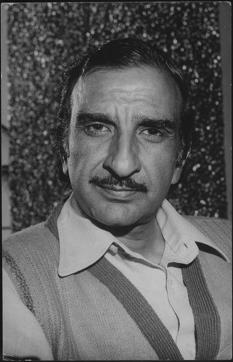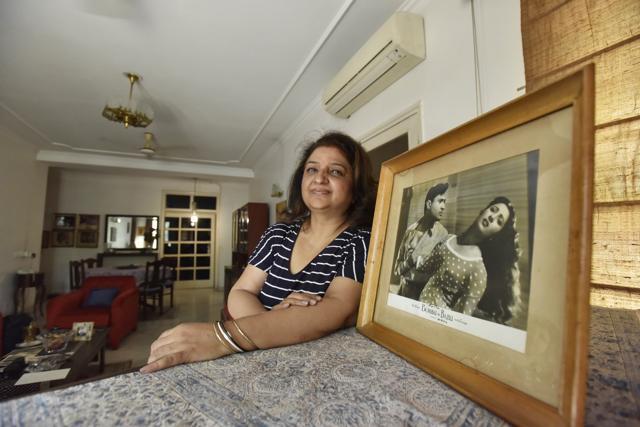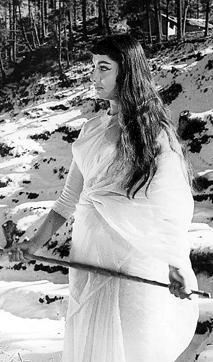Raj Khosla, India’s answer to Alfred Hitchcock and Bollywood’s master of thrills
Alfred Hitchcock would have turned 119 this month. A look at how Raj Khosla, one of the top Hindi film directors of the ’50s-’80s imbibed Hitchcock’s spirit, moulding it to suit the Indian audience
The night is black as pitch; a car makes its way through the rain and comes to a halt. The headlights show a woman in white in its path. The driver, a young doctor on his way home, asks her a few questions; her answers indicate this will be an interesting meeting.

He gives her a lift, she responds to him in a flat monotone throughout the journey, and says at one point that she “likes blood” as if she were expressing a liking for marmalade, and gets off at a graveyard whose gates creak open at her approach. [Many scenes later, the doctor (Manoj Kumar) has an arranged marriage with a woman (Sadhana) with an uncanny resemblance to the mysterious woman, and it nearly throws him and his marital life off gear.]
This opening scene of Woh Kaun Thi?, one of the most successful suspense flicks of commercial Hindi cinema, owes its spirit – the obsessive pursuit of a woman (as seen in Vertigo, Dial M for Murder) – and its pacing to Alfred Hitchcock, the master of psychological thrillers and crime noir in the ’20s-’70s Hollywood. The structure and content of the film are, of course, all Raj Khosla’s. Khosla was a top director-producer of ’50s-’80s Bollywood. His films of murder, suspicion and mayhem were all played out in the seemingly stable but most volatile of Indian institutions – the family.
In Bombai Ka Babu (1960), Woh Kaun Thi? (1964), Mera Saaya (1966), Anita (1967) and Naqaab (1989), Khosla focussed on the man-woman relationship with all its potential for sin, crime, misunderstandings, and, of course, reconciliation.

The inky-shadowed interiors of the home of the richest man of a village on the mountains into which an escaped convict Babu (Dev Anand in Bombai...) enters and is mistakenly welcomed as the long-lost son mirror Babu’s fear-stricken close-ups as he falls in love with his beautiful ‘sister’ (Suchitra Sen). They recall the great Hollywood director in the way Hitchcockian and noirish interior or mental states are expressed by exterior settings of place. [The word ‘noir’ was coined by the French for an American genre of films, the stylish crime dramas].
In Woh Kaun Thi?, Mera Saaya and Anita, the outsider in the family – the wives in the first two films and the cash-strapped boy who wants to marry his rich girlfriend and is hence assumed to be a gold-digger in the latter – is ascribed with the ability to create havoc in the family; their entry is an alert for impending chaos. The timid and socially awkward Judith as the second wife in Hitchcock’s Rebecca, who tiptoes around her husband and his retinue of disapproving servants, played to similar on-screen expectations.
Hitchcock, however, bulwarked his plots with big universal themes -- individuals at the mercy of impersonal forces that cannot be immediately understood (in The Man who Knew Too Much); nature is unpredictable and man never harness it (Birds); and that innocence and guilt in a human being are mixed up which is why there are, in his films, no clear villains and even they are charming (Rebecca).

Veteran actor Prem Chopra, whose role as the villain of Woh... gave him his first major break in Hindi industrial cinema, says commercial films in India don’t risk ambiguity. “Directors think the audience doesn’t know the difference between good and bad, so let’s tell them. So our heroes are all white, our villains all black.” But he is thankful to Khosla for attempting a variation, even if it was for a two-scene role in Mera Saaya. “I was a dacoit but not a repulsive character. He made a girl die in my arms.” [Sadhana in a double role harks back to another Hitchcockian trope –mistaken identity. She plays the twin sister, the dacoit’s companion, as well. Khosla used the double role (Anita) and the doppelganger trick (Naqaab) too.]
In all of Khosla’s thrillers, the fight is within the family, and the crime is usually about property. The murder, unlike in most Hitchcocks, is always deeply personal.

Hitchcockian influence
Narratives of a country can be, but are rarely, delinked from its mythologies. And popular cinema interprets lives through those myths. Khosla was, therefore, constructing his version of Hitchcock based on what has conventionally been considered good and evil in India.
“A cinema hall is not the place where you get 200-odd people together and get them to confront their deepest, darkest natures, especially if they enter it thinking they are good people. We have had grey spaces, we have had anti-heroes but the moral compass of our industry is Mother India,” says director Mahesh Bhatt, who considers Khosla as one of his mentors and joined his crew for Do Raaste, a film made after the latter’s noir phase. “Mother India is the woman and mother who dotes on her son, but whom she kills for violating the principles on which society runs… the son cannot disturb the father of a daughter even if he is a tyrant, that’s the heartbeat of the narrative. No Raj Khosla film was going to trifle with social mores or the idea of feminine virtue.”
Anita Khosla, one of the filmmaker’s daughters, says her father did come from a conservative family “but no one picturised songs as well as he did. There was never a cheap shot. He shot Sadhana in sari and pearls as she sang out her desire, Lag ja gale in Woh Kaun Thi.”

Producer Johny Bakshi who was a production assistant of Khosla’s, says the late director always made women the centre of his suspense thrillers because he believed they were interesting even when they were showing their on-screen weaknesses, their vulnerabilities. “A component of desire has to be at the centre of a commercial entertainment industry,” he says. “A man longs for a woman. A woman can send a man to his grave. She may even sing in a graveyard and no one will find it ridiculous.”
Songs in noir
“In his thrillers, Hitchcock keeps us psychologically engaged as well as emotionally upset while Khosla’s noir intensity becomes more entertaining, albeit enduring, through his songs,” adds film historian Amrit Gangar.
Khosla served Hitchcock all warmed up. Says Gangar: “Hitchcock’s films chill, which is the cornerstone of the crime thriller genre. But even in the building up of an atmosphere of suspense, Khosla would whip up a song and propel the narrative.” That is, Hitchcock would use orchestral music to underline the ‘noir’ fright, Khosla would use a song to suspend it so that he could ratchet it up again, he adds. In C.I.D (1956), Waheeda Rahman’s charming performance as she dances to Kahin pe nigahe... which keeps the audience on tenterhooks and almost makes them believe that the inspector hero (Dev Anand) is at real risk of being caught hiding in the home of the crime boss as she waylays the latter on the staircase, serves this very purpose. Veteran lyricist-filmmaker Amit Khanna recalls the “long tracking shots and his use of the round trolley” that would focus on the character’s face and expressions at key moments in the film.
Raj Khosla was not the only one inspired by Hitchcock in Bollywood but he directed a string of films that were huge successes and showed that the career of noir was flourishing outside the West. Biren Nag’s 1964 horror film Kohraa starring Waheeda and Biswajeet Chatterjee was based on Rebecca; Dev Anand borrowed from How to Catch a Thief to make Jewel Thief (1965). In the age of Alfred Hitchcock there were only two things to be done: Copy Hitch. Or try not to.
Get more updates from Bollywood, Taylor Swift, Hollywood, Music and Web Series along with Latest Entertainment News at Hindustan Times.
Get more updates from Bollywood, Taylor Swift, Hollywood, Music and Web Series along with Latest Entertainment News at Hindustan Times.






